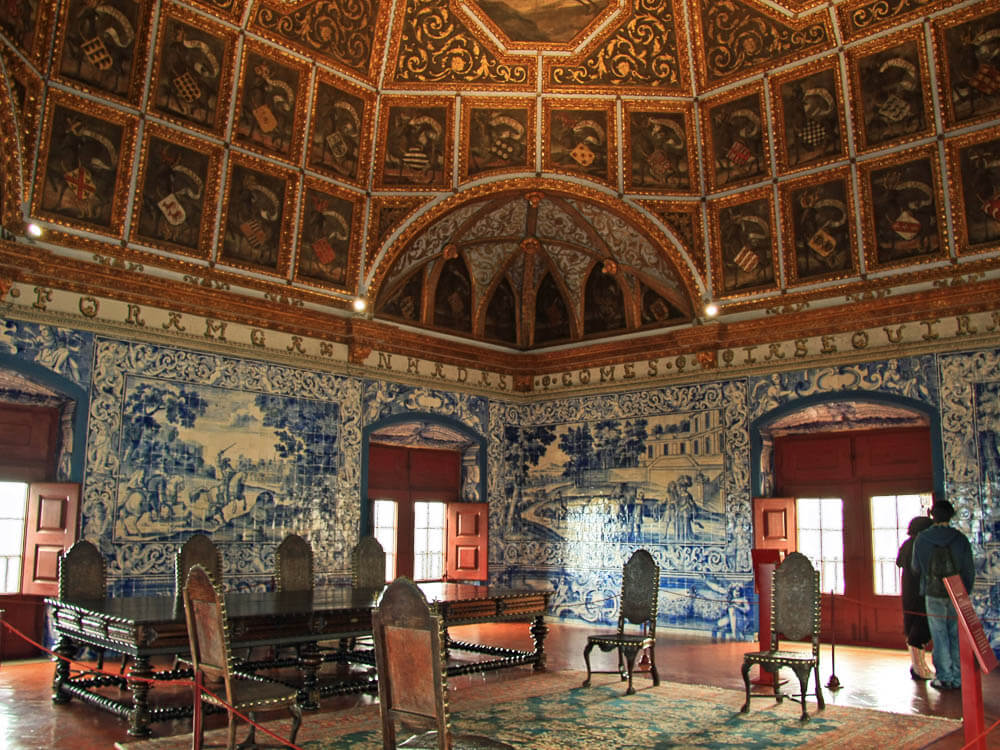Explore the history, artistry, and cultural significance of the tiles in Lisbon, the beautiful azulejos that are synonymous with Portuguese culture.
One of the most recognizable and important aspects of Portuguese culture is the traditional blue-and-white azulejos. These ceramic tiles have been part of the country’s history for centuries, and can be found everywhere in the city from churches and palaces to everyday homes.
With mesmerizing patterns and vibrant colors, each tile tells us a little bit about Portugal’s heritage, transforming even the simplest streets into open-air galleries.
In this guide, I’ll share some of the best places to see these beautiful tiles around Lisbon and share places where you can buy some for yourself.
Trust me, after seeing tile panels in all their glory, you’ll definitely want to bring some of that beauty home with you!
Index
- History of azulejos
- Best places to see tiles in Lisbon
- Where to buy tiles in Lisbon?
- Tile workshops in Lisbon
- Where to stay to appreciate tiles in Lisbon?

1. History of Azulejos
To understand the importance of azulejos to Portuguese culture, we have to go back to the 13th century, during the Moorish occupation. That’s when these glazed ceramic tiles were introduced to Portugal, and ended up becoming an integral part of the country’s heritage.
The Moors ruled the Iberian Peninsula for 4 centuries, which, as you can imagine, greatly influenced the region’s culture. That’s why even the word azulejo comes from the Arabic word for polished stone.
By the 15th century, Lisbon had already become synonymous with azulejos, as was known for its tile-covered façades, both in religious and residential buildings. Initially, they were used mainly for insulation and fire protection, but became more popular after the 1755 earthquake due to their affordability and ease of production during reconstruction.
In the 19th century, azulejos became symbols of wealth in bourgeois homes, which often featured intricate designs. However, their popularity decreased in the early 20th century, due to architectural and industrial shifts.
It was only in the 1950s that the traditional tiles became popular again, as artists started using them for public art projects, such as decorating Lisbon’s metro stations.
Today, azulejos are a valued part of Portugal’s heritage, contributing to the country’s unique architectural identity and attracting tourists from all over the world.
2. Best places to see tiles in Lisbon
2.1. National Tile Museum

The National Tile Museum in Lisbon, located in a former convent from 1509, is an absolute must-visit for anyone who appreciates this form of art.
It holds a large collection of ceramics focused on azulejos, and the exhibits are organized chronologically to help visitors understand how tiles have evolved over different periods.
One of the main exhibits is a 23-meter long panoramic cityscape of pre-earthquake Lisbon, made from about 1,300 blue and white tiles. Not only is this panel beautiful, but also provides a rare insight into how the city looked before it was destroyed by the 1755 earthquake.
The National Tile Museum also provides specialized activities, such as a reservation-only tile painting class, which allows visitors to learn about traditional techniques and actually make their own tiles.
2.2. Fronteira Palace

Fronteira Palace, built in the 17th century, is often called the Sistine Chapel of Tilework, due to its remarkably detailed tilework depicting historical and mythological stories.
The use of azulejos throughout the palace’s rooms and halls are a testament to why Lisbon tiles are celebrated globally, and it’s definitely a place that all art and history lovers should visit!
Among the highlights is the Room of Battles, where you’ll find azulejo panels with scenes of wars and heroes, and ceilings decorated with classical deities such as Venus and Minerva.
Additionally, there’s the Gallery of the Arts, which displays mythological scenes and statues of Greek gods surrounded by azulejos with matching imagery and color.
2.3. Monastery of São Vicente de Fora

The Monastery of São Vicente de Fora, located near Alfama, is dedicated to the patron saint of Lisbon, St. Vincent, and serves both as a place of worship and a repository for historical and artistic artifacts.
The highlight of the monastery is, without a doubt, the cloisters. They’re home to what is considered the world’s largest collection of 18th-century azulejos, with over 100,000 pieces!
The panels illustrate both religious and secular themes in detail, and there are 38 panels entirely dedicated to the satirical fables by Jean de La Fontaine. It’s amazing to see not only the artistic skills involved in creating these azulejos, but also how they can be used for storytelling and educational purposes.
2.4. Metro Stations

Lisbon’s metro stations are not just transit points but also showcase Portugal’s tile art tradition, notably through Maria Keil’s work.
Since the 1950s, Keil has designed azulejos for 19 metro stations across the city. Her designs blend functionality with visual appeal, integrating local artistic heritage into daily commutes.
Oriente Station is a prime example, featuring azulejos that depict aquatic scenes with mermaids and sharks. It transforms an ordinary stop into a unique visual experience that reflects Lisbon’s maritime history.
Olivais Station, with its olive tree-themed azulejos, acknowledges Portugal’s agricultural roots and provides a visually calming environment within the urban setting.
The use of azulejos in these stations helps preserve and share Portuguese artistic legacy, as they act as public galleries that enrich the daily travel experience for both locals and tourists.
2.5. National Palace of Sintra

The National Palace of Sintra, just 30 minutes from Lisbon, was commissioned by King Manuel I and blends Moorish and Manueline styles, inspired by the Royal Alcazar in Seville. Inhabited since the 15th century, the palace was a favorite among Portuguese royalty.
One of its highlights is the Room of the Coats of Arms, with a gold-domed ceiling adorned with the coats of arms of 72 notable Portuguese families, serving as both decoration and historical record.
Besides that, many rooms are adorned with traditional blue and white azulejos that depict scenes from imperial life, highlighting Portugal’s rich tradition in ceramic tile artistry and appealing to those interested in historical tiles.
2.6. Old Cathedral of Coimbra

The Old Cathedral of Coimbra was built in the 12th century when Coimbra was Portugal’s capital. It combines religious function with a fortress-like design, typical of Portuguese cathedrals from this era, which reflects the need for defensible religious buildings during unstable times.
In the 16th century, Bishop Jorge de Almeida sponsored artistic upgrades to the cathedral’s interior, which included the addition of azulejos tiles with Arab geometric motifs, a testament to the connection between Moorish and Portuguese culture.
Although some of these historic tiles have been removed over the centuries, the remaining ones continue to attract visitors with their detailed beauty. This tile work makes the Old Cathedral of Coimbra an incredible artistic site, which I highly recommend visiting!
3. Where to buy tiles in Lisbon?
So, you’ve visited all the places I mentioned above and now you want to purchase some Portuguese tiles to take home. That’s absolutely great! However, there are two words you need to keep in mind before buying azulejos: “ethical purchasing”.
Here’s the thing: it’s not uncommon for tiles to be illegally removed from historical sites and sold as second-hand azulejos. That’s why I have to advise you against buying from unknown sellers or at places like Feira da Ladra.
You may find a lot of options there, but there’s a high chance these tiles could be stolen, which only fuels the black market demand and ends up damaging Portugal’s historical heritage. This is such a common problem that the police even created a department called “SOS Azulejo”, which is dedicated to preventing tile theft and protecting cultural assets.
To help you find authentic and ethically sourced Lisbon tiles, I’ve selected a couple of reputable stores that ensure you get genuine products while also supporting local artists and helping preserve cultural artifacts. So, here are my recommendations:

3.1. Sant’Anna Factory
The Sant’Anna Factory, located in the Lapa neighborhood of Lisbon, has been operational since 1741 and gained popularity after the 1755 earthquake, when it played a key role in the city’s reconstruction by producing traditional tiles.
To this day, the factory is committed to using old techniques to make each tile, ensuring that they are made with care and reflect designs from past centuries.
Visitors to the Sant’Anna Factory can tour the workshop to see the tile-making process, and can also purchase souvenir tiles or order custom reproductions based on historical designs from the 17th and 18th centuries.
3.2. Solar Antiques
Solar Antiques, located in central Lisbon, is recognized as the world’s largest store dedicated exclusively to original tiles. Managed by Verónica Leitão, a third-generation tile dealer, the store offers a wide array of azulejos dating from the 15th to the 19th centuries.
The store not only sells historic tiles but also educates customers about their importance and maintenance, actively supporting the preservation of Portuguese azulejo culture for future generations.
Prices at Solar Antiques vary significantly, with unique pieces costing thousands of euros due to their historical importance and rarity, while more affordable options are available for around 10 euros per tile. So, I’m sure you’ll be able to find something that fits your budget!
3.3. Azulejos de Azeitão
Azulejos de Azeitão, located in the wine-making town of Azeitão just 25 minutes south of Lisbon, is a small tile factory that specializes in traditional Portuguese tiles. It produces handcrafted tiles using age-old techniques and designs typical of Portuguese history.
Visitors can see the detailed process involved in creating both embossed and flat tiles and watch artisans paint patterns on each tile. The small studio space allows for a close-up view of the craftsmanship, revealing the artistic skill required and explaining why each piece is unique.
3.4. XVIII – Azulejo and Faiança
XVIII – Azulejo & Faiança, located in the Alfama district of Lisbon, specializes in tiles and pottery inspired by 18th-century designs.
The products at XVIII feature designs reflecting historical trends, with many items made on-site, which ensures style authenticity and offers customization options for specific décor needs without purchasing actual antiques.
So, if you’re looking to incorporate classical-style tiles or pottery into your home, XVIII is a great shop to visit!
3.5. Viúva Lamego
Viúva Lamego, originally a tile and ceramic factory, is now a respected shop in central Lisbon. Its exterior is adorned with traditional Portuguese azulejos depicting flowers, fruit trees, and animals. Angels displaying the year 1865 mark when Viúva Lamego was established.
Inside, you’ll discover a wide range of tiles with both historical and modern designs, and you can either purchase tiles directly or order reproductions based on patterns from the 16th to 18th centuries.
3.6. Surrealejos
Surrealejos is an unconventional tile store situated in the Castelo neighborhood, founded by designer Luca Colapietro. It reimagines traditional Portuguese azulejos with surrealistic elements, transforming them into art pieces that challenge conventional design norms.
The tiles there tend to feature depictions of animals, skulls, pop culture elements, and modern patterns, blending contemporary styles with traditional tile-making techniques.
While it may not be everyone’s cup of tea, it’s a great way to preserve the essence of azulejos while expanding their appeal through diverse influences.
In addition to tiles, this shop offers products such as t-shirts, framed tile panels, and DIY kits for creating tiled walls.
So, if you’re seeking non-traditional azulejos in Lisbon, Surrealejos presents a modern perspective on this historic art form that could be exactly what you want!
4. Tile workshops in Lisbon

Attending tile workshops in Lisbon is a great way to explore azulejo production and preservation. They provde hands-on experiences suitable for both beginners and those familiar with ceramics. Here are some places you can go to make your own tiles:
- Cerâmica S. Vicente: operated by Cristina Pina and her son Miguel, this studio is located near Alfama and Castelo de São Jorge. It offers workshops for tile painting and sells artisanal pieces, an ideal choice for those interested in learning the craft while visiting Lisbon’s historic sites.
- A Loja dos Descobrimentos: located in Alfama and operating since 1986, this shop features ceramics and tiles from across Portugal. It also includes a studio where visitors can paint tiles themselves, providing an authentic experience of traditional Portuguese tile-making.
- A Casa do Azulejo: run by ceramist Ana Dominguez offers training focused on Portuguese tile along with contemporary ceramics techniques. The atelier celebrates ancient art forms using traditional methods and invites visitors to participate in classes or workshops.
5. Where to stay to appreciate tiles in Lisbon?
If you still haven’t had enough of azulejos, I’ve got good news! There are some amazing accommodations that feature tiles in their decoration, allowing you to experience local artistry directly from your hotel room. Here are my recommendations of places you can stay to enjoy tiles in Lisbon:
- Azulejos Cais Sodré B&B: for a central stay, this hotel is a great option. It offers city views and proximity to landmarks like Commerce Square and Rossio. It’s also close to attractions such as St. George’s Castle and Dona Maria II National Theatre. The decoration of each room is unique, and they’re equipped with private bathrooms and free WiFi.
- Casa Dos Azulejos: situated in Lisbon’s quiet Lapa district, close to Santos Train Station and about 4 km from the city center. The accommodation features walls decorated with traditional Portuguese tiles, along with modern amenities. Includes free WiFi, a full kitchen, balcony, TV sofas area, and private bathrooms.
- Palacio Ramalhete: a hotel to experience luxury mixed with lots of historical charm. Located in an 18th-century palace just a three-minute walk from the Museum of Ancient Art. This hotel has rooms decorated with antique furniture and ceramic tiles and provides views over the Tagus River. It balances historical ambiance with comforts like air conditioning, flat-screen TVs, breakfast buffet, bar and pool, ideal for a culturally rich yet relaxing stay.
The most beautiful tiles in Lisbon await your visit!

In Portugal, azulejos, or ceramic tiles, are much more than just a decorative art: they represent the country’s heritage, reflecting cultural changes and historical events.
The origin of tiles in Lisbon goes back to the Moorish rule, and spans across all the centuries since then, with motifs ranging from 16th-century designs to contemporary artistic interpretations. And, walking through the city, you’ll get to see live examples of this!
Experiencing the culture of tiles in Lisbon is definitely an experience like no other, one that I’m sure you’ll love every second of. I hope this guide has been useful, and that you have a great time there.
Oh, and if you have any other suggestions of places to see tiles in Lisbon, tell me in the comments!







